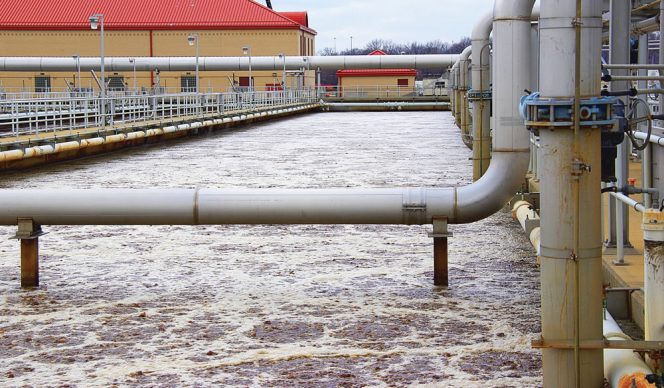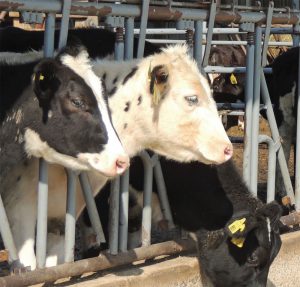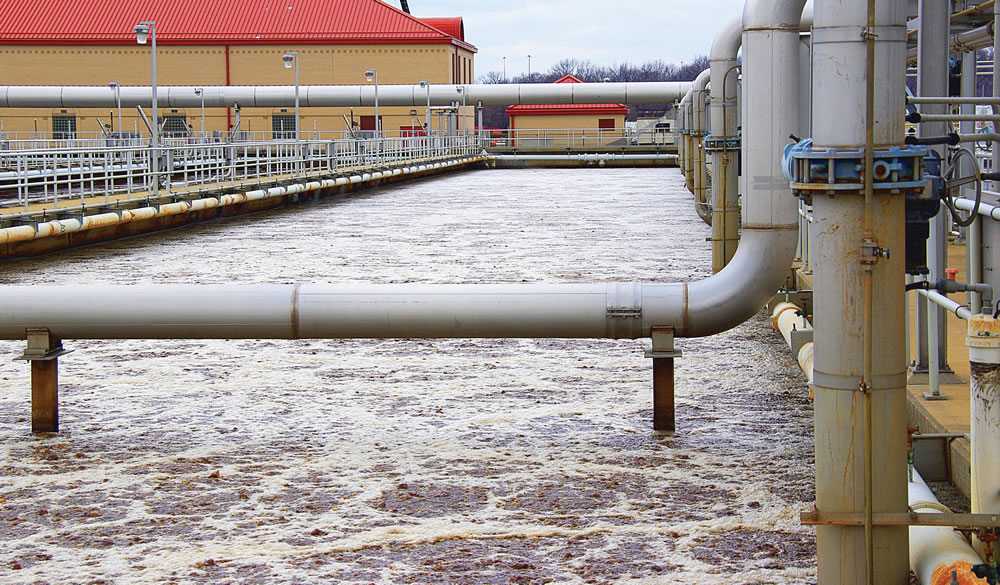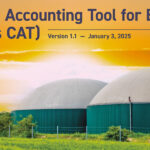Recent developments in the state of Maryland show that progress can be a work in progress.
Michael H. Levin
BioCycle March/April 2019

The final rule bars direct trades between wastewater treatment plants (WWTP) as a means to avoid new pollution “hotspots” and requires a tighter WWTP “performance baseline” for trades of credits from WWTPs
to other sources.
“Wastewater bubbling” by Kristian Bjornard [CC BY-SA 2.0] via Wikimedia Commons (cropped, adjusted)
Maryland recently capped the latest chapter of its 10-year effort to implement nutrient credit trading. In July 2018, the Maryland Department of Environment (MDE) issued comprehensive final rules for when and how inexpensive “extra” reductions in nitrogen (N), phosphorus (P) or sediment (S) discharges from nonpoint sources like farms may be used to satisfy stringent clean water mandates for point sources like factories, wastewater treatment plants (WWTPs) or storm water overflows (45 MD Register 698, 2018).
Trade Credit Journey
MDE began its journey before 2008 with rules generally limited to point source trades. It proceeded through variations first allowing nonpoint sources (NPS) to provide “growth offsets” that neutralize point source increases, then trades between certain classes of NPS, and then trades between certain point and nonpoint sources. Early in 2016, MDE embarked on steps that potentially could have allowed trades between all source types, watershed-wide or across state lines.
Over the next 18 months, MDE initially proposed broad new trading rules, plus a pilot program for direct state procurement of nutrient reduction credits through Requests for Proposals (RFPs) seeking more cost-effective reductions. Then, without public explanation, it withdrew its pilot and replaced its proposed rules with narrower versions that it ultimately adopted. This was done despite MDE stating that flexible trades between source types were crucial to attain clean water, and repeatedly declaring that without such trades billions of additional tax dollars would have to be spent seeking reductions from sources (e.g., storm water) with per pound reduction costs up to a thousand times greater than reduction costs at other sources (e.g., agricultural runoff).
Maryland’s shift in course shows how regulatory systems cling to equilibrium — and how hard it is to move that needle when stakeholders have dug-in investments in the status quo. To understand why, consider some details.
The Procurement Pilot
Through 2016 MDE drafted, tweaked and sought support for pilot legislation that would reallocate $10 million of the state’s $60 million Bay Restoration Fund for direct competitive-bid purchase of “cost-effective nitrogen and phosphorus nutrient [reduction] credits … to restore the health of the Chesapeake Bay” (HB 325, Jan. 2016). MDE generated successive issue papers — basically shadow rules — refining how such nutrient credit procurement (NCP) would work. Partly for simplicity — but also because the $10 million would come from Bay funds allocated to the N-discharging septic tank sector — MDE limited its proposed pilot to N credits.
To encourage access to RFP credit auctions for farms and other small dischargers, MDE cut biddable credit quantities from 1,000 to 250 pounds/year. It excluded bids from strictly regulated WWTPs, as those reductions generally are financed by the public. MDE also declared that because “the State has no way to compel non-permitted sectors [like farms and septic tanks] to make reductions other than to pay for them … more cost-effective [market-based] solutions are needed for Maryland to achieve its [Restoration] goals.” Importantly, it added, state purchase of 5 to 15 year streams of credits would “establish a framework for [private] investors to front the funds to build [nutrient reduction measures] and seek a guaranteed profit” (MDE Draft issue paper, Dec. 2016).
This good-faith effort collided with politically influential WWTPs seeking to preserve or increase public funding for pollution control upgrades. Then it became mired in intercounty squabbles over how state-purchased credits should be allocated to reduce municipal pollution control obligations.
In February 2017, MDE suddenly replaced its proposed NCP pilot with a “competitive grant” proposal — for further reductions by “non-agricultural sectors” only — that appeared to apply cost-effectiveness lipstick mostly to continued subsidies for municipal WWTP and storm water reductions. According to the Baltimore Sun, “After opposition from environmentalists and local governments and receiving little interest from farmers, the administration is [scaling back its] plan” (Wood, 2017).
It’s unclear how much pilot outreach to genuine farmers was involved. The only identifiable “private farm” commenter, the National Milk Producers Association, pointedly noted its “disappointment that the plan to take $10 million from the Bay Restoration Fund to use as seed money to kick start the trading program by purchasing nutrient [reduction] credits, was sidelined by unknown parties.” The lipstick alternative may have been MDE’s attempt to salvage some of its hard work. It apparently was not enacted.

Beneficial improvements for agricultural operations include clearer baselines beyond which nearly all sources could generate tradeable credits of nitrogen, phosphorus or sediment. Photo by Doug Pinkerton
Final Trading Rule
Meanwhile MDE floated numerous discussion drafts of a flexible trading rule, and eventually proposed that rule (Oct. 2017). Then it promptly overwrote this proposal with a less ambitious version (Dec. 2017). Six months later it adopted that narrower rule.
The final rule featured some beneficial improvements. These included stronger provisions for third-party credit verification; clearer “baselines” beyond which nearly all sources could generate tradeable credits of N, P or S; clauses to prevent dischargers with publicly funded reduction measures from selling credits produced by those measures; and more predictable procedures for registering and credibly advertising “credits wanted” or “for sale.”
The rule also:
• Rejected environmental groups’ requests for an across-the-board 2:1 “trade ratio” for any trade involving NPS (e.g., 2 lbs of verified reduction from a farm = 1 lb of tradeable credit) — even where point sources were not involved or NPS reductions reliably could be quantified.
• Declined to adopt additional vague safety margins whose uncertainty could have discouraged beneficial trades.
• Grandfathered completed trades against adverse regulatory changes till the next 5-year permit renewals.
• Affirmed that trades could be used only for further progress towards water quality standards, above and beyond reductions from “Best Available Technology” for point sources like WWTPs and “Best Management Practices” for farm, septic tank or storm water discharges.
Barred WWTP/WWTP trades (to avoid new pollution “hotspots” or use of “anyway credits” from routine operation of existing pollution control equipment like advanced denitrification) and required a tighter WWTP “performance baseline” for trades of credits from WWTPs to other sources. These outcomes confounded many WWTPs, which apparently had expected to generate (not merely buy) credits despite consensus views that new cost-effective nutrient reductions largely would come from farms.
However, the rule also walked back important parts of MDE’s initial proposal. For example, it:
• Prohibited all interstate trades even on a pilot basis, though the Chesapeake is a single water body and the broader a trade area the greater the likely cost reductions. It then went further, dividing Maryland’s portions of the Bay into three separate “trade regions” whose lines no trade easily could cross.
• Deployed multiple trade ratios: 1:1 between storm water point sources and “unregulated” sources like septic systems; 2:1 between NPSs and WWTPs “unless the credit generator demonstrates that a lower ratio is justified;” a general additional “Edge of Tide” adjustment “to normalize loads based on delivery to the mainstem of the Bay;” and a “5 percent reserve” subtracted from all remaining credits to cover contingencies like partial credit delivery or unanticipated discharges due to population growth.
This layered approach sought to provide nuanced rather than blunt force water quality protection. But it offered potentially fertile ground for disputes and confusion. So may other provisions of the rule. For example, it continued to hold credit buyers (not credit generators) primarily responsible for compliance if contracted credits fail to materialize, making credits inherently risky despite third-party verification. And it appeared to require that each point source trade be confirmed by formal case-by-case permit modifications — a potentially unpredictable process whose length could undercut timely approvals.
Some observers already have begun to question whether the final rule will encourage sufficient real-world trades to make a difference in Bay restoration or associated state nutrient reduction costs. While the rule still is young, the prognosis does not seem rosy. Experience and analyses indicate that where short-term risks or perceived uncertainties for applicants start to outweigh future financial benefits, trades become rare — and mostly may be used for isolated emergencies like providing WWTP or industrial dischargers more time to install required upgrades. In fact, though the rule went into effect July 16, 2018, as of January 15, 2019, no new trades apparently have occurred. MDE’s on-line program to connect credit sellers with credit buyers was still “under construction.”
The rule’s underlying goal — eliciting large volumes of inexpensive verified nutrient reductions from farms — may be problematic. Moreover, its incentives could deteriorate if the Trump EPA’s new Waters of the U.S. (“WOTUS”) Rule survives to put many wetlands, tributaries and other Bay contributors beyond federal jurisdiction, leaving the state less political cover to seek reductions in discharges affecting such sources. Thus Maryland may have more work to do.
If and when MDE turns to that task, it could have help from a Bay neighbor to the north. Pennsylvania legislation creating a full-blown statewide NCP program passed that state’s senate by an overwhelming majority last year. After unrelated delays due largely to redistricting tumult and introduction of a wild-card bill to grant Pennsylvania dioceses immunity from future child-abuse prosecutions, that legislation is expected to be enacted this spring. It rests on NCT cost-effectiveness principles but is designed to bypass both the need for individual trades and multiple constraints inhibiting them, saving the state more than 80 percent of its projected $11 billion cost of Bay compliance by more conventional means. If it pans out as projected, MDE may be able to point to a nearby success story that should make its next-round efforts — and the ability of AD projects to benefit from them — easier to attain.
Mike Levin, a BioCycle Contributing Editor, is managing member of the virtual law firm Michael H. Levin Law Group, PLLC (Washington DC) and a principal in NLGC, LLC and Carbon Finance Strategies LLC, which respectively focus on capital formation for renewable-energy projects and the optimization / development of ground-mounted solar PV facilities. From 1979-1988 he was national Regulatory Reform Director at the U.S. EPA. NLGC is financial advisor to a proponent of Nutrient Credit Procurement. Some quotes in this article are edited for simplicity.













